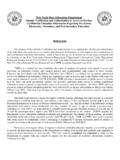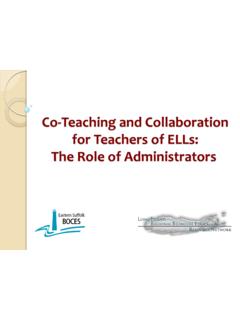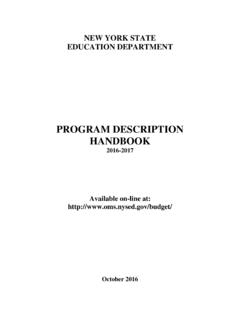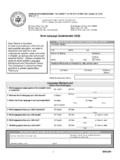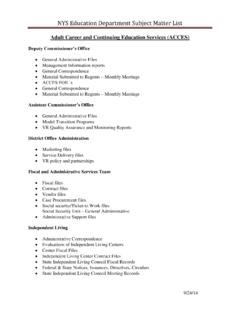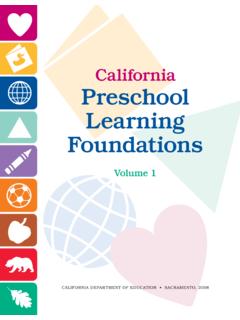Transcription of Successful School Leadership What It Is and How It ...
1 Successful School LeadershipWhat It Is and How It Influences Pupil LearningKenneth Leithwood, Christopher Day,Pam Sammons, Alma Harris and David HopkinsResearch Report RR800 RESEARCH Successful School Leadership What It Is and How It Influences Pupil Learning Kenneth Leithwood, Christopher Day, Pam Sammons, Alma Harris and David Hopkins The views expressed in this report are the authors and do not necessarily reflect those of the Department for Education and Skills. University of Nottingham 2006 ISBN 978 1 84478 822 4 Research Report No 800 2 Contents 1. THE THE MEANING OF THE SIGNIFICANCE OF School 2. The Nature of Successful Leadership JUSTIFYING THE CORE Leadership CORE PRACTICES AND COMPARATORS BASED ON RESEARCH IN School CORE PRACTICES AND COMPARATORS BASED ON RESEARCH IN NON- School THE CORE PRACTICES A Theoretical (But Practical) Perspective on the Core Setting Developing Redesigning the Managing the Instructional (Teaching and Learning) 3.
2 Distribution of Successful THE EFFECTS OF DISTRIBUTED FORMS AND PATTERNS OF DISTRIBUTED 4. Roots of Successful Leadership COGNITIVE CHARACTERISTICS OF Successful Intelligence and Other Intellectual Problem AFFECTIVE CHARACTERISTICS OF Successful Social Appraisal Skills : emotional 5. From Successful Leadership Practices To Pupil HOW LEADERS INFLUENCE THEIR IMMEDIATE Followers Leaders TEACHERS INTERNAL Classroom School Conditions in the 3 6. 4 Preface We wish to acknowledge particularly the contributions on research on Leadership in South East Asia by Professor Allan Walker, Chinese University of Hong Kong. They provide an important perspective to this international review. 5 Rationale This is a wide - ranging review of theory and evidence about the nature, causes and consequences for schools and students of Successful School Leadership . We undertook the review for several purposes. One purpose was to provide a state-of-the-evidence description of what is already known about Successful Leadership .
3 We anticipated that such a description would be of some immediate use and guidance to those already in Leadership positions and those with responsibilities for the development of leaders. A second purpose for the review was to help frame the large-scale study of Successful Leadership now underway with the sponsorship of the DfES and the National College for School Leadership . The review helped us to clarify the most important questions for inquiry, offered conceptual lenses on key variables of interest to our study and was a source of information about promising research methods. Third, we believe that, given widespread dissemination, the review will help build a demand and audience for the results of our large-scale study as they become available. Finally, the review may spark an interest in Leadership on the part of those who have not, to this point, given it much thought. Evidence included in the review is of two types. One type of evidence was original empirical research undertaken using a wide variety of methods.
4 While an extensive body of such evidence is included in the review, we did not attempt to be exhaustive; that would clearly have been unrealistic in a paper of this length. Rather we gave special weight to work reported in the past decade, as well as to work of higher quality judged by conventional standards. We also made use of recent comprehensive reviews of research published in peer-review sources. The use of this type of evidence allowed us to reflect work reported over a relatively long period of time and to be more comprehensive in our coverage than would have been possible had we limited ourselves to individual studies alone. Use of the reviews also allowed us to judge, more 6 accurately, emerging conclusions warranted by significant amounts of evidence. We provide more detail about our sources of evidence in the concluding section of Chapter One. 7 1. Introduction The State-of-the-Confusion Leadership is a high priority issue for many people concerned with education these days.
5 Reformers depend on it. The public believes that it is what schools need more of. It is not surprising, then, that so many people are trying to make a living peddling their latest insights about effective educational Leadership . Indeed Leadership by adjective is a growth industry. We have instructional Leadership , transformational Leadership , moral Leadership , constructivist Leadership , servant Leadership , cultural Leadership , and primal Leadership (Goleman, Boyatzis & McKee, 2002). A few of these qualify as Leadership theories and several are actually tested Leadership theories. But most are actually just slogans. Consider, for example, the terms, especially popular in North America, instructional Leadership and, in England, learning-centred Leadership : they typically serves as synonyms for whatever the speaker means by good Leadership with almost no reference to models of instructional or learning-centred Leadership that have some conceptual coherence and a body of evidence testing their effects on organizations and pupils.
6 With all this confusion about the concept of Leadership in our environment, we might be persuaded to think that hard evidence about what is good or Successful or effective Leadership in education organizations is lacking or at least contradictory but we would be wrong. We actually know a great deal about the Leadership behaviours, practices, or actions that are helpful in improving the impact of schools on the pupil outcomes that we value. As one example, the review of educational Leadership effects on pupil learning reported almost 10 years ago by Hallinger and Heck (1996) included about 40 studies. And many more have been reported since then. 8 One source of confusion in sorting out what we know about Successful School Leadership is that much of the educational Leadership literature does not focus on actual Leadership practices at all. It is about leaders values, beliefs, skills or knowledge that someone thinks leaders need in order to act in an effective manner, which may be inferred from observation of leaders at work, or which, may be reputed as contributing to leader effectiveness by a range of people who experience Leadership .
7 A popular Leadership literature has grown up around Goleman s (1994) idea of emotional intelligence. But this is an internal state, rather than an overt behaviour. Other, small scale empirical research which focuses upon leaders values in action and their emotional qualities which impact on effectiveness does, however, exist internationally ( Day et al, 2000; Sugrue et al, 2004). While leaders internal states are interesting and obviously important what leaders do depends on what they think and feel no one experiences or knows the internal states of others except as they manifest themselves in some kind of externally expressed attitude or act. The empirical evidence linking any leader s internal state to their use of effective Leadership practice, something we review below, although growing, is not yet extensive; and, whilst we acknowledge its importance, it does not form part of this present review. The most visible examples of unwarranted assumptions or links between internal states and overt Leadership practices are Leadership standards: the ISSLC standards in the United States (Council of State Chief Council of Chief State School Officers, 1996); the standards driving Leadership development in England ( teacher Training Agency 1998) and which were revised in 2004 (NCSL 2004) and others developed in Queensland, Australia, and New Zealand, for example (see Ingvarson, Anderson, & Gronn, 2006, for a thorough review of these standards and many others).
8 Almost all of these standards, in addition to identifying Leadership practices, spell 9 out long lists of knowledge, skills, and dispositions that leaders should have or acquire on the assumption that they are needed for effective Leadership practice. The accumulated body of research on Successful educational Leadership has much less to say about this matter than a reading of the standards would suggest. In contrast, the accumulated empirical evidence has a great deal to say about effective Leadership practices, and by far the largest amount of this evidence is about the Leadership of School principals or headteachers. A much smaller but still significant proportion is about the Leadership of senior district/LA administrators. In addition, there is a rapidly growing body of evidence about teacher Leadership ( , Murphy, 2005) and distributed Leadership ( , Spillane, 2006), sometimes considered closely related. But so far this evidence is mostly descriptive, primarily generated through small qualitative studies.
9 And the results of these studies are actually quite disappointing. The most recent and comprehensive review of the teacher Leadership literature ( york -Barr & Duke, 2004; see also Murphy, 2005) was able to locate only five empirical studies of teacher Leadership effects on pupils and none reported significant positive effects. Moreover, both teacher Leadership and distributed Leadership qualify as movements driven much more by philosophy and democratic values than by evidence that pupils actually learn more if a larger proportion of School Leadership comes from non-traditional sources. Some advocates claim that the more Leadership the better, that the capacities of the organization are realized more fully as the sources of Leadership expand and that we should, as Sergiovanni (1999) has recommended, aspire to leaderful organizations in which everyone should be a leader. However, this argument has three flaws. 10 First, it asserts an empirical claim that more Leadership is better.
10 So far this claim has received no support from the small amount of relevant empirical research that has been reported, assuming better has some reference to pupil learning. One recent study, for example, examined the effects of many different sources of Leadership on pupil engagement in School and found that total Leadership the sum of the Leadership provided from all sources was unrelated to such engagement, whereas the Leadership of the principal was significantly related (Leithwood & Jantzi, 2000). A second flaw in the everyone is a leader argument begs the question, what do we mean by Leadership ? Much of the teacher Leadership literature either describes teacher leaders engaged in administrative tasks or engaged in what most professions would agree are the normal responsibilities expected of a collection of professionals. Shared decision making and collaboration, for example, are really quite important to the success of schools. But why do we need to call them distributed Leadership ?

